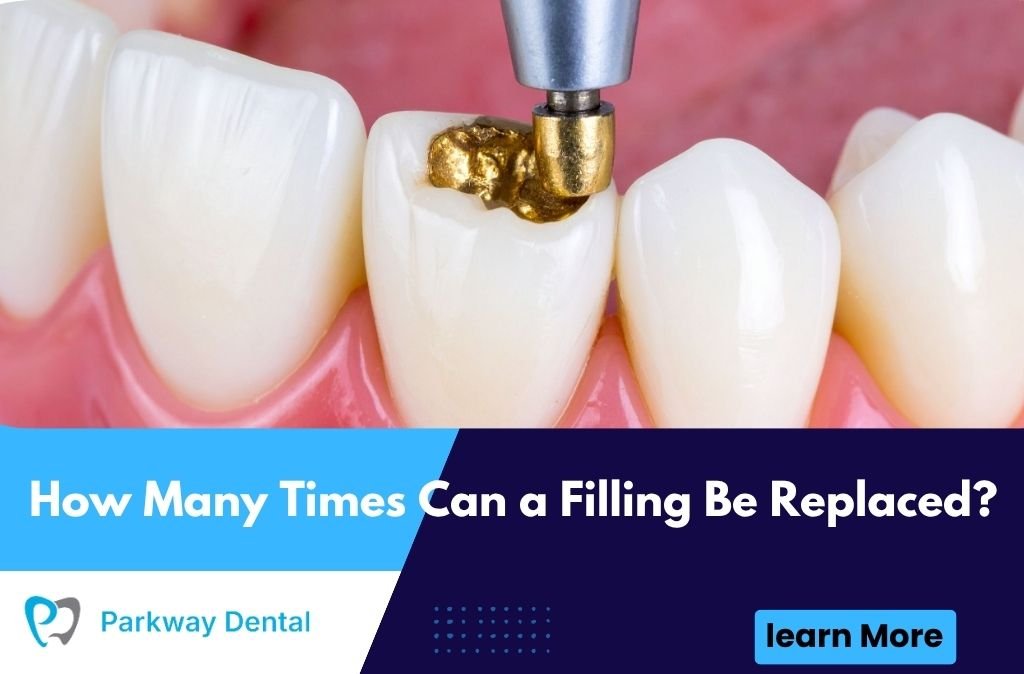Dental fillings are one of the most common restorative procedures performed in dentistry, designed to repair teeth damaged by decay and restore their function and integrity. While fillings are durable and can last many years, they’re not permanent solutions that last forever. Eventually, most fillings will need to be replaced due to wear, damage, or recurrent decay. This reality leads many patients to wonder about the longevity of their dental restorations and ask an important question: how many times can a filling actually be replaced? Understanding the factors that limit filling replacement, what happens with each successive replacement, and how to maximize the lifespan of your fillings helps you make informed decisions about your dental care and potentially avoid more extensive treatments. This comprehensive guide explores everything you need to know about replacing dental fillings and protecting your natural teeth for the long term.
Table of Contents
Understanding Why Fillings Need Replacement
Before addressing how many times fillings can be replaced, it’s important to understand why these restorations eventually fail and require replacement in the first place.
Common Reasons for Filling Failure
Dental fillings can fail for numerous reasons, even when they’re properly placed and well-maintained. Normal wear and tear from years of chewing gradually breaks down filling material, causing it to wear away or become thin. Fillings can crack, chip, or fracture from biting on hard foods, teeth grinding, or simply the stress of constant use over time. The seal between the filling and tooth structure can deteriorate, creating gaps where bacteria can enter and cause new decay around or underneath the filling—a condition called recurrent or secondary decay. Some filling materials, particularly older amalgam fillings, can expand and contract with temperature changes, eventually weakening the tooth structure around them. Poor oral hygiene that allows new cavities to form adjacent to existing fillings, changes in tooth structure from additional decay or trauma, and simple aging of materials that have exceeded their expected lifespan all contribute to filling failure. Regular dental checkups allow your dentist to monitor your fillings and identify problems before they become serious, often catching issues when they’re still relatively easy to address.
Signs Your Filling Needs Replacement
Several symptoms indicate that a filling may need replacement. Sensitivity to hot, cold, or sweet foods and drinks can signal that the seal around your filling has failed or that new decay has developed. Pain when biting down might indicate a cracked filling or recurrent decay underneath the restoration. Visible damage like chips, cracks, or dark spots around the filling margins requires evaluation. A rough or uneven feeling when you run your tongue over the filling, food consistently getting caught around a filled tooth, or visible gaps between the filling and tooth structure all warrant attention. If you notice any of these signs, schedule a dental appointment promptly rather than waiting for your regular checkup, as early intervention often allows for simpler, more conservative treatment.
The Replacement Limit: Why It Exists
While there’s no absolute, universal number of times a filling can be replaced, there are practical limitations based on tooth anatomy and the need to preserve sufficient healthy tooth structure.
Tooth Structure Loss with Each Replacement
Every time a filling is replaced, additional tooth structure must be removed. Your dentist must remove the old filling material completely, clean out any new decay that may have developed, and often remove a thin layer of surrounding tooth structure to create clean margins for the new filling. This means that with each successive replacement, your tooth becomes progressively smaller and weaker. After multiple replacement cycles, you may reach a point where insufficient tooth structure remains to adequately support another filling. The tooth walls may become too thin, the overall structure too compromised, or the cavity too large for a filling to be practical or predictable. At this stage, more extensive restorations like crowns, inlays, onlays, or even root canal treatment may become necessary to save the tooth.
Factors Affecting Replacement Limits
The number of times a specific filling can be replaced varies considerably based on several factors. The size of the original cavity plays a crucial role—small fillings can typically be replaced more times than large ones because there’s more healthy tooth structure to begin with. The location of the filling matters, as teeth that endure heavy chewing forces (like molars) may require more tooth removal with each replacement compared to teeth with lighter stress. The quality and durability of filling materials used affects how long fillings last and how much tooth structure must be removed during replacement. Your oral hygiene practices and dietary habits influence how quickly new decay develops around fillings. Individual tooth anatomy, enamel thickness, and overall tooth size impact how many times structure can be removed while maintaining tooth integrity. Some patients might have a filling replaced four or five times over their lifetime before requiring more extensive restoration, while others might need alternative treatments after just two or three replacements.
What Happens After Multiple Replacements
Understanding the progression from simple fillings to more complex restorations helps you appreciate the importance of maintaining your fillings and catching problems early.
When Fillings Are No Longer Sufficient
After multiple filling replacements, the tooth may reach a point where a filling alone can no longer provide adequate restoration. This typically occurs when more than half the tooth structure is missing or compromised, the remaining tooth walls are thin and fragile, the cavity is very deep and close to the nerve, or the tooth has cracked or fractured in ways that filling material cannot adequately repair. At this stage, your dentist will likely recommend a more comprehensive restoration that provides better protection and support for the compromised tooth structure.
Alternative Restoration Options
When teeth can no longer be adequately restored with fillings, several alternatives exist. Dental crowns cover the entire visible portion of the tooth, providing comprehensive protection and reinforcement for heavily filled or weakened teeth. Inlays and onlays are intermediate restorations that are more extensive than fillings but more conservative than crowns, custom-made to fit precisely within or over portions of the tooth. If decay has reached the tooth’s nerve, root canal treatment may be necessary before placing a crown to save the tooth. In severe cases where the tooth cannot be saved, extraction followed by replacement with a dental implant, bridge, or partial denture becomes necessary. While these treatments are more involved and expensive than simple fillings, they’re often the only way to preserve function and prevent further problems when teeth have been repeatedly filled.
Maximizing Filling Longevity
The best way to manage the limited number of filling replacements is to maximize how long each filling lasts, reducing the frequency of replacement and preserving tooth structure.
Proper Oral Hygiene Practices
Excellent home care is crucial for extending filling lifespan. Brush at least twice daily with fluoride toothpaste, paying special attention to the margins where fillings meet natural tooth structure, as these areas are particularly vulnerable to decay. Floss daily to remove plaque and food particles from between teeth and around fillings where cavities commonly develop. Consider using an antimicrobial mouth rinse to reduce bacteria that cause decay. Electric toothbrushes often remove plaque more effectively than manual brushing, potentially reducing decay risk around fillings. Avoid using your teeth as tools to open packages or crack nuts, as this can damage both natural teeth and fillings. These simple practices significantly reduce the risk of recurrent decay around fillings, which is one of the primary reasons fillings need replacement.
Regular Dental Visits
Professional dental care plays an essential role in filling longevity. Schedule checkups and cleanings every six months so your dentist can monitor your fillings for early signs of wear, cracking, or marginal breakdown. Professional cleanings remove tartar and plaque that contribute to decay around fillings. Dental X-rays taken periodically help detect decay developing underneath fillings before it becomes visible or symptomatic. Early detection of filling problems allows for timely replacement before extensive additional decay develops, preserving more tooth structure with each replacement cycle. Your dentist can also identify risk factors like teeth grinding or dietary issues that may be compromising your fillings and recommend solutions.
Lifestyle and Dietary Factors
Your daily habits significantly impact filling longevity. Limit sugary and acidic foods and beverages that promote tooth decay, especially around existing fillings. If you grind your teeth at night, wear a custom nightguard to protect both your natural teeth and fillings from excessive forces that cause cracking and wear. Avoid chewing on hard objects like ice, hard candy, or pen caps that can damage fillings. If you play contact sports, wear a mouthguard to protect your teeth and restorations from trauma. Stay hydrated and address dry mouth issues, as saliva helps protect teeth and fillings from decay. Quitting smoking improves overall oral health and reduces complications with dental restorations. These lifestyle modifications help your fillings last longer and reduce the frequency of replacement.
Modern Filling Materials and Longevity
The type of filling material used significantly influences how long restorations last and how many times they can be replaced before alternative treatments become necessary.
Composite Resin Fillings
Tooth-colored composite resin fillings are now the most common type used, especially for visible teeth. These fillings bond chemically to tooth structure, which can help strengthen the tooth and require less removal of healthy structure compared to older materials. Composite fillings typically last seven to ten years with proper care, though longevity varies based on size, location, and individual factors. The bonding properties of composite materials mean that replacements can often be performed conservatively, potentially allowing for more replacement cycles before alternative restorations become necessary. However, composite fillings can stain over time and may wear faster than other materials in areas of heavy chewing pressure.
Amalgam and Other Materials
Traditional silver amalgam fillings, while less commonly used today for aesthetic reasons, are extremely durable and can last 15 years or longer. However, amalgam fillings require more mechanical retention, meaning more tooth structure must be removed initially and potentially with each replacement. Gold and ceramic inlays and onlays are premium options that offer exceptional durability—often lasting 15 to 30 years—but are more expensive. Glass ionomer fillings release fluoride that helps protect against decay but are less durable and typically used only in low-stress areas or as temporary restorations. Discussing material options with your dentist helps you choose the best restoration for your specific situation, balancing longevity, aesthetics, and cost considerations.
Planning for Long-Term Dental Health
Understanding the limitations of filling replacement helps you take a long-term approach to dental health that preserves your natural teeth as long as possible.
The Importance of Prevention
The best strategy is preventing cavities in the first place, eliminating or reducing the need for fillings entirely. Strong preventive care through excellent home hygiene, regular professional care, fluoride use, dental sealants on vulnerable teeth, and a tooth-healthy diet protects your natural tooth structure. Every filling you avoid means preserving more natural tooth structure for life. Even if you already have fillings, preventing new cavities reduces the overall burden on your teeth and the need for additional restorations.
Making Informed Decisions
When a filling needs replacement, having informed discussions with your dentist about your options is important. Ask about the extent of new decay or damage, how much additional tooth structure must be removed, whether a filling is still appropriate or if a more extensive restoration would be better long-term, what material options exist and their relative benefits, and what you can do to maximize the longevity of the new restoration. Sometimes accepting a more comprehensive treatment like a crown earlier in the replacement cycle, rather than continuing to replace large fillings repeatedly, can actually preserve more tooth structure and provide better long-term outcomes. Your dentist can help you understand the trade-offs and make decisions that support your long-term dental health.
Conclusion
While there’s no definitive answer to exactly how many times a filling can be replaced—as it depends on numerous individual factors—the general principle is that each replacement removes additional tooth structure, eventually reaching a limit where alternative restorations become necessary. Most fillings can be replaced several times over a patient’s lifetime before more extensive treatment is required, but the specific number varies based on the original cavity size, tooth location, filling materials, and how well you care for your teeth. The key to managing this limitation is maximizing how long each filling lasts through excellent oral hygiene, regular dental care, and healthy lifestyle choices that reduce decay risk.
If you have concerns about existing fillings, wonder whether your fillings need replacement, or want to discuss the best long-term strategy for your dental health, consider consulting with an experienced Dentist in West Roxbury, MA who can thoroughly evaluate your situation and provide personalized recommendations. With proper care and professional guidance, you can preserve your natural teeth and maintain excellent oral health throughout your life, minimizing the need for repeated filling replacements and more extensive dental work.






